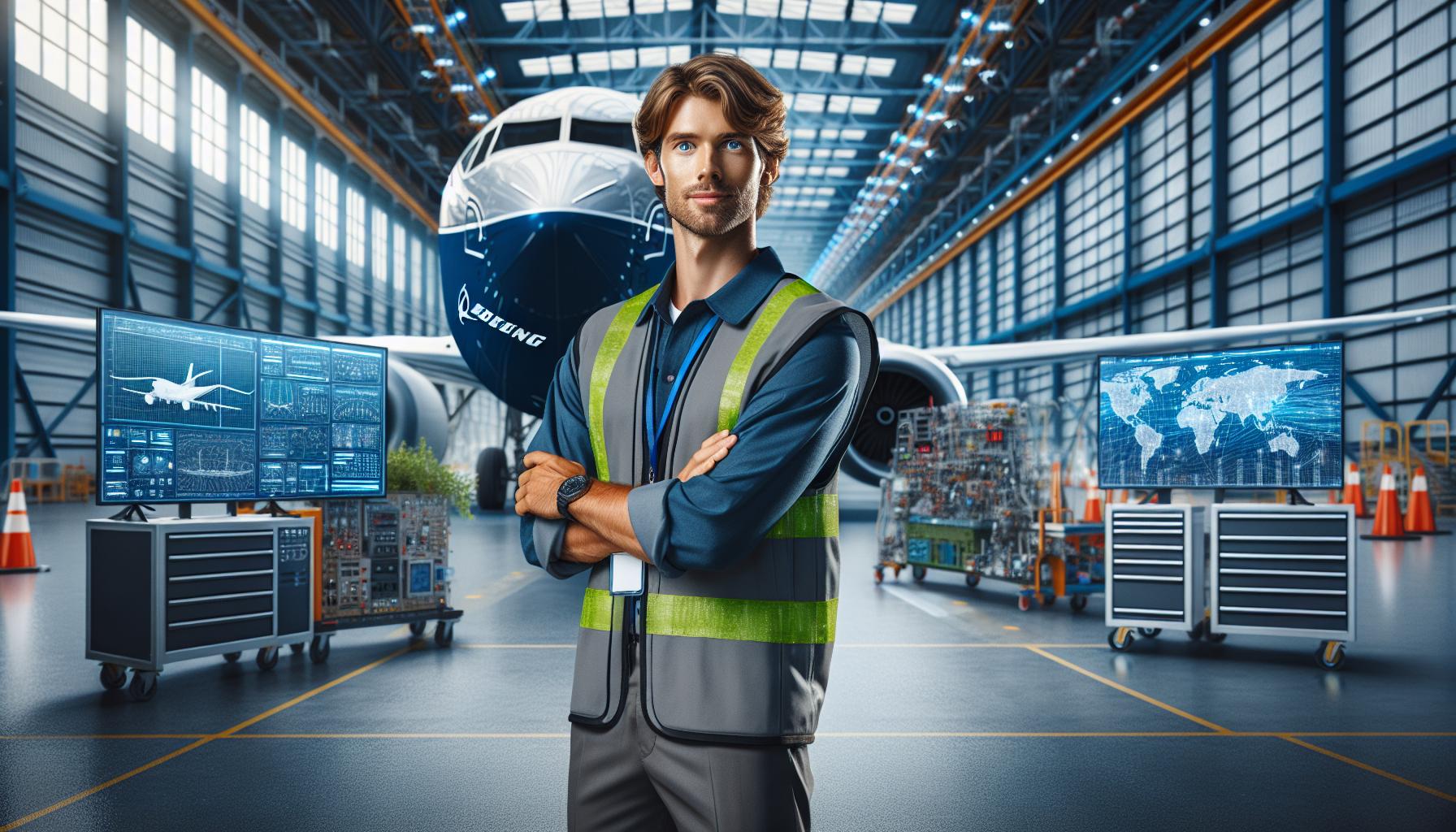When you think of Issaquah, what comes to mind? Nestled in the heart of Washington State, it’s a place known for its natural beauty and small-town charm. But did you know it also has a rich history of innovation and aviation, thanks to a deep-rooted connection with Boeing?
The story of Boeing in Issaquah is a fascinating journey, filled with pioneering spirits and technological marvels. It’s a tale that intertwines the growth of a global aerospace giant with the development of a humble town. So buckle up, we’re about to embark on a thrilling flight through time, exploring Issaquah’s Boeing connection and its history of innovation.
A Glimpse into Issaquah’s Boeing Connection
Issaquah’s relationship with Boeing, the renowned aerospace giant, is a story of collaboration, shared growth, and resilience. Let’s delve into the beginning of this incredibly symbiotic connection.
The Early Years
In the 1920s, as Issaquah was growing from a small coal-mining town to a bustling community, Boeing was simultaneously penning its beginning chapters in Seattle. Issaquah’s strategic location amidst tall cedar trees, loggers, and an abundance of rivers provided it with an edge. It quickly became an invaluable resource for Boeing’s budding airplane production by supplying timber for airplane wings and propellers. This marked the beginning of Issaquah’s role as a critical contributor to Boeing’s pioneering aviation efforts.
Milestones in the Partnership
Issaquah’s connection with Boeing took a monumental leap in the 1940s when Boeing chose the town to set up a significant part of its airplane production machinery. This fortuitous alignment transformed Issaquah from a mere timber supplier into a strategic partner of Boeing. Ranging from the production of the Boeing 314 Clipper, a luxury liner of the skies during the ’30s, to today’s engine technology advancements in the 787 Dreamliner, Issaquah and Boeing have shared numerous milestones together. This partnership showcases Issaquah’s commitment to fostering innovation and stands as a testament to a longstanding collaboration that has enriched aviation history.
Boeing: A Pillar of Innovation
Boeing’s relentless pursuit of innovation reverberates from the pioneering achievements in aeronautics to the cutting-edge technological innovations, making it a pillar of innovation in Issaquah’s history.
Pioneering Achievements in Aeronautics
Boeing holds a rich tradition of pioneering achievements in aeronautics. In the 1930s, it’s the birthing ground for Boeing 314 Clipper, often regarded as the first, real long-range commercial airliner. It made expedient international travel feasible, cutting transatlantic flight times drastically to around 19 hours. Likewise, in the 1950s, Boeing set another benchmark with the introduction of the 707, the world’s first reliable commercial jet. Through the release of the wide-body 747 in the 1970s—known as the “Queen of the Skies”—they revolutionized long-haul travel. These milestones in aeronautics not only mark Boeing’s journey but also the history of aviation itself.
Technological Innovations
Boeing’s drive for innovation extended to key technological advancements that transformed the aircraft industry. An important achiever on this front is the 787 Dreamliner, introduced in 2007. Thanks to its carbon fiber composite materials, it significantly reduces weight while maintaining high strength, leading to substantial improvements in fuel efficiency. In addition, the Dreamliner nourishes poise for innovation, introducing larger, electronically-dimmable windows and an advanced onboard air filtration system that ensures fresher, cleaner, more humid air, enhancing passenger comfort. In essence, Boeing’s technological innovations redefined the parameters for future achievement in the aviation industry.
Impact on Issaquah’s Development
Boeing’s close ties with Issaquah distinctly marked the town’s trajectory of development. Its economic prosperity and infrastructure growth tie back to the influence of this aviation giant.
Economic Prosperity
With the advent of Boeing’s operations in Issaquah, the economic landscape transformed radically. Previously, the town relied on coal mining. I saw the paradigm shift as local workers moved from the mines to Boeing’s aircraft factories. The company’s labor needs injected life into Issaquah’s job market, slashing unemployment rates critically. It wasn’t simply about new jobs. A domino effect ensued, stirring ancillary businesses like restaurants, retail stores, and transportation services. Local shops thrived, catering to the growing population of Boeing employees. Simultaneously, this economic pivot boosted property values, making Issaquah an increasingly attractive place to live.
Infrastructure Growth
Boeing’s evolution paralleled an observable infrastructure surge in Issaquah. This town, once a quaint coal-mining settlement, witnessed infrastructure overhauls reflective of a flourishing economy. I recall the construction of new roads, public utilities, and transportation facilities to support Boeing’s business activities and the resultant population influx. Among the most notable developments, Boeing’s dedicated flightline at Renton Airport stands out. It exemplifies the town’s transition from mining to aviation, a symbol of modernity against the backdrop of Issaquah’s rustic charm. On the other hand, it’s hard to miss the impact on educational facilities, such as increased funding for schools and colleges to train the next generation of aviation professionals. Unquestionably, Boeing’s involvement etched a lasting legacy on Issaquah’s infrastructure and development.
Personal Stories from Issaquah’s Boeing Employees
Let’s dive into the personal archives of some of Issaquah’s proud Boeing employees.
Working in the Forefront of Innovation
No surprise, working at Boeing tests one’s ability to adapt and innovate. According to James, an aerospace engineer, the design and testing process of the 787 Dreamliner challenged his engineering skills to the hilt. “At Boeing, you’re not just working,” he recounts, “you’re pioneering!” For Lisa, a manufacturing specialist, the construction of the Boeing 747, a mammoth of an aircraft, was just as monumental. Experiences like these are not an exemption but a rule for Boeing’s workforce.
Pride and Challenges
The pride of being a Boeing employee intertwines with overcoming challenges. Tom, a seasoned mechanic, often managed long hours and tight deadlines during the rollout of the fuel-efficient 787 Dreamliner. “The air in the production hall was thick with anticipation,” he shares, “but when you witness the aircraft you built taking flight for the first time, it’s worth it!” For Mary, a project manager during the production of the Boeing 314 Clipper, balancing the efficiency and safety of a project was a constant tug of war, but she’s informed me it came with immense satisfaction. That’s the spirit of being part of Boeing’s innovation history.
Boeing’s Resilience: Emerging from Crises
Boeing’s journey has been a testament to resilience, marked by its ability to navigate turbulent periods and to bounce back stronger. Stories from Boeing’s past, shared by workers from Issaquah, paint a picture of a company that’s been repeatedly tried by fire but has always emerged refined.
Steps Towards Recovery: Post 737 MAX Crisis
The 737 MAX crisis presented one of the most formidable challenges in Boeing’s history. In March 2019, two of these planes tragically crashed, setting in motion a chain of events that took a heavy toll on the company. However, Boeing demonstrated resilience and commitment to safety. Responding decisively, it grounded all 737 MAX aircrafts worldwide until the concerns could be addressed.
The next months saw Boeing embarking on an exhaustive review and update process of the 737 MAX’s flight control system. These measures were taken to avert future accidents, underscoring Boeing’s commitment to flight safety. In parallel, concerted efforts were made to rebuild trust with the public, airlines, and regulators. In November 2020, the Federal Aviation Administration (FAA) finally cleared the 737 MAX for commercial service again, marking a significant step in Boeing’s recovery effort.
Despite facing severe financial strain, Boeing persevered, motivated by a vision to redefine the future of flight. It focused not just on overcoming setbacks but on leveraging them to drive innovation and improvement. The 737 MAX episode thus stands as a testament to Boeing’s resilience, demonstrating how it can rise from crises, stronger and more committed to safety. Boeing’s workers from Issaquah were an integral part of this journey, embodying the spirit of determination and innovation that has characterized the company’s history.
Issaquah-Boeing: Looking into the Future
Using Issaquah’s valued history with Boeing as a springboard, I’ll now cast an eye towards the future. Curiosity-stirring advancements and eco-friendly initiatives indicate a forward-thinking trajectory for Issaquah-Boeing relations.
Next-Generation Innovations
In today’s fast-paced, high-tech world, Boeing isn’t resting on its laurels, and neither is Issaquah. Instead, I see a continued commitment to path-breaking innovation. Efforts focus particularly on artificial intelligence (AI) and digital twin technology, with Issaquah’s Boeing workforce heavily involved. One example: the development of autonomous, AI-powered drones capable of unprecedented involvement in search and rescue missions. Similarly, digital twin technology, which sees the creation of virtual, real-time replications of physical assets, is another area of exploration for Boeing in Issaquah. This technology’s potential to predict maintenance needs and optimize flight routes signifies a revolution in aviation.
Sustainability Initiatives
Turning our gaze to environmental concerns, I can’t ignore Boeing’s earnest strides towards sustainability. Issaquah’s Boeing workforce is at the heart of these initiatives, actively participating in endeavors aimed at reducing the company’s environmental footprint. One can’t miss mentioning the groundbreaking ecoDemonstrator program, exploiting cutting-edge technology to improve fuel efficiency and reduce aircraft noise levels. In addition, Boeing aims for carbon-neutral growth by 2020, and has set a deadline to use 100% sustainable fuels in aircraft testing and delivery flights by 2030. In essence, Boeing’s commitment to sustainability, driven in part by Issaquah’s dedicated workers, shows a promising future that pairs innovation with environmental responsibility.
Conclusion
So, we’ve journeyed through the remarkable history of Issaquah’s partnership with Boeing, seeing how this town has played a crucial part in Boeing’s aviation triumphs and technological evolution. We’ve also witnessed Boeing’s resilience in the face of adversity, with their unwavering focus on safety and recovery. As we look forward, it’s clear that the bond between Issaquah and Boeing is only growing stronger, fueled by a shared commitment to innovation and sustainability.
What really excites me about the future is the active engagement in cutting-edge technologies like AI and digital twin technology. Plus, there’s the impressive dedication to green initiatives. Boeing’s ecoDemonstrator program and their goal for carbon-neutral growth are truly commendable. It’s this fusion of innovation and environmental responsibility that promises a bright future for Boeing and Issaquah. Here’s to a future where technology and sustainability go hand in hand.





0 Comments